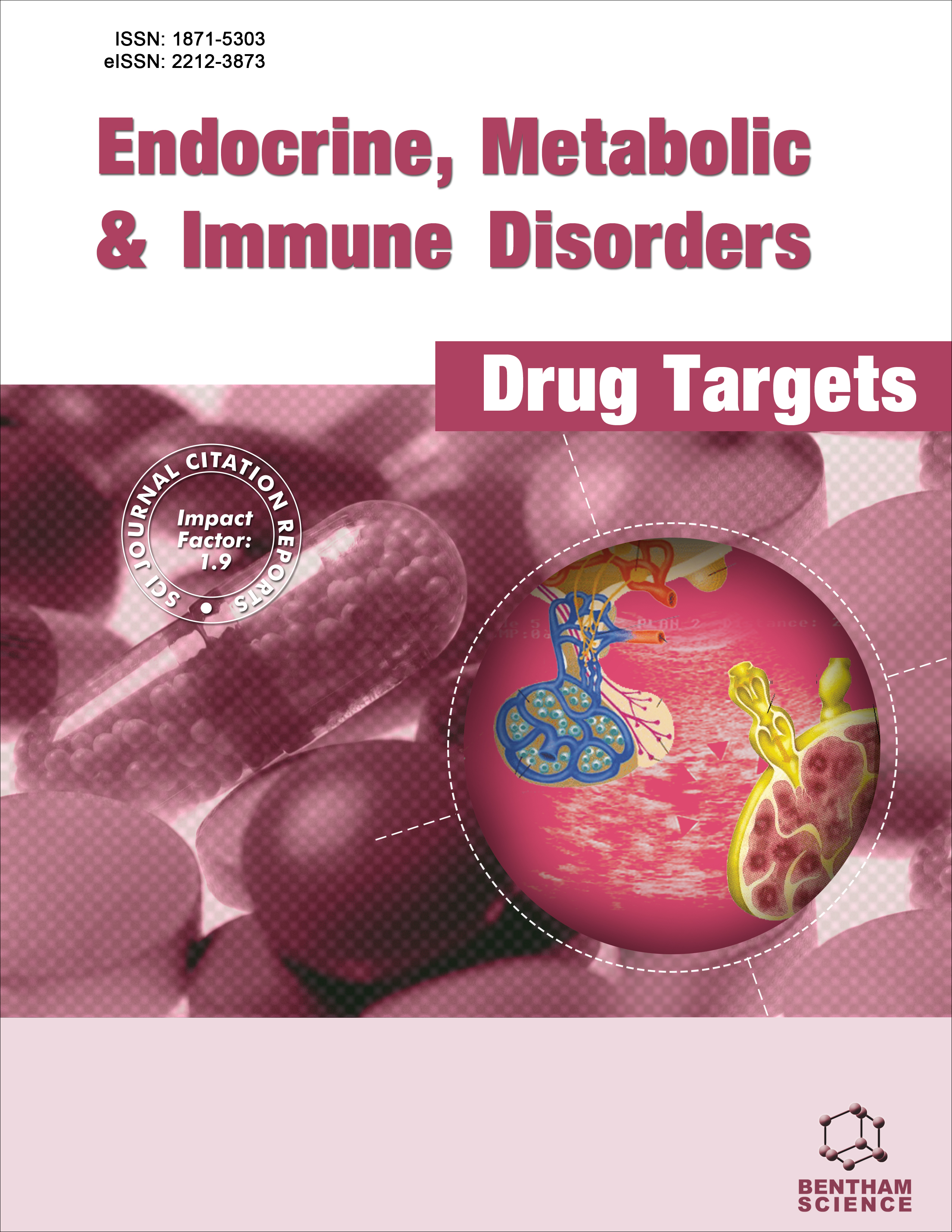- Home
- A-Z Publications
- Endocrine, Metabolic & Immune Disorders-Drug Targets (Formerly Current Drug Targets - Immune, Endocrine & Metabolic Disorders)
- Previous Issues
- Volume 8, Issue 3, 2008
Endocrine, Metabolic & Immune Disorders-Drug Targets (Formerly Current Drug Targets - Immune, Endocrine & Metabolic Disorders) - Volume 8, Issue 3, 2008
Volume 8, Issue 3, 2008
-
-
Celiac Disease: Pathogenesis and Novel Therapeutic Strategies
More LessAuthors: Mariella Baldassarre, Anna M. Laneve, Roberto Grosso and Nicola LaforgiaCeliac disease is a digestive disease, considered as an autoimmune disorder, that damages the small intestine and interferes with absorption of nutrients. Individuals affected by celiac disease cannot tolerate a protein called gluten, present in wheat, rye, and barley, but also in other common products such as stamp and envelope adhesive, medicines, and vitamins. Celiac disease is a genetic condition that is triggered—or beco Read More
-
-
-
Cannabinoids as Therapeutic Agents for Ablating Neuroinflammatory Disease
More LessAuthors: G. A. Cabral and L. Griffin-ThomasCannabinoids have been reported to alter the activities of immune cells in vitro and in vivo. These compounds may serve as ideal agents for adjunct treatment of pathological processes that have a neuroinflammatory component. As highly lipophilic molecules, they readily access the brain. Furthermore, they have relatively low toxicity and can be engineered to selectively target cannabinoid receptors. To date, two can Read More
-
-
-
Genome Study of Kidney Disease in the Age of Post Genome-Sequencing
More LessAuthors: Kent Doi, Koji Okamoto, Katsushi Tokunaga, Toshiro Fujita and Eisei NoiriThe genome-based study of human disease has been developing rapidly with the completion of the human genome project and the remarkable progress of technology. The genetic variation information associated with disease will certainly enable us to discover potential drug targets and to develop personalized medicine. Chronic kidney disease (CKD) is now recognized as a public health problem because its prevalence is inc Read More
-
-
-
Harnessing CD36 to Rein in Inflammation
More LessAuthors: M. S. Parsons, L. Barrett, C. Little and M. D. GrantMaintaining health requires a dynamic balance between the influence of pro-inflammatory and antiinflammatory mediators. While inflammation serves an important protective role against infection, unrestrained inflammation is acutely lethal and unresolved inflammation contributes to a broad range of chronic disorders. Immunotherapy with cytokines themselves or cytokine antagonists faces strict limitations due to effica Read More
-
-
-
Allosteric Modulators of the Human Calcium-Sensing Receptor:Structures, Sites of Action, and Therapeutic Potentials
More LessBy Jianxin HuThe human extracellular Ca2+-sensing receptor (CaR) plays a key role in the regulation of serum calcium and parathyroid hormone. This large dimeric receptor consists of domains with topologically distinctive orthosteric and allosteric sites. Positive allosteric modulators of the CaR, which increase CaR activation and thereby decrease secretion of parathyroid hormone, are potential for the treatment of primary and second Read More
-
-
-
Trends in Metabolic Syndrome and Gene Networks in Human and Rodent Models
More LessMetabolic syndrome (MetS) can be considered a pheno-physiological cluster of metabolically interrelated risk factors for diabetes mellitus and cardiovascular disease. MetS has emerged as a result of complex interactions among environmental stresses and MetS gene networks and their products. In this review we summarize trends in MetS definitions, their associated controversies and possibilities for their refinement. Th Read More
-
-
-
Bone Morphogenetic Protein-Smad Pathway as Drug Targets for Osteoporosis and Cancer Therapy
More LessBy Baojie LiBone morphogenetic proteins (BMPs) are members of the TGF-β superfamily. Engaging of BMPs to BMP receptors on the cell surface leads to activation of the receptor kinase activity, which phosphorylates Smad1/5/8. Smad1, 5, or 8, with Smad4, forms a complex, which is translocated to the nucleus, where it binds to the consensus DNA sequence to regulate the transcription of BMP target genes. BMP-Smad signaling regul Read More
-
-
-
Critical Role of the Endocannabinoid System in the Regulation of Food Intake and Energy Metabolism, with Phylogenetic, Developmental, and Pathophysiological Implications
More LessAuthors: M. P. Viveros, F. R. de Fonseca, F. J. Bermudez-Silva and J. M. McPartlandThe endocannabinoid system (ECS) consists of two receptors (CB1 and CB2), several endogenous ligands (primarily anandamide and 2-AG), and over a dozen ligand-metabolizing enzymes. The ECS has deep phylogenetic roots and regulates many aspects of embryological development and homeostasis, including neuroprotection and neural plasticity, immunity and inflammation, apoptosis and carcinogenesis, pain and emoti Read More
-
Volumes & issues
-
Volume 25 (2025)
-
Volume 24 (2024)
-
Volume 23 (2023)
-
Volume 22 (2022)
-
Volume 21 (2021)
-
Volume 20 (2020)
-
Volume 19 (2019)
-
Volume 18 (2018)
-
Volume 17 (2017)
-
Volume 16 (2016)
-
Volume 15 (2015)
-
Volume 14 (2014)
-
Volume 13 (2013)
-
Volume 12 (2012)
-
Volume 11 (2011)
-
Volume 10 (2010)
-
Volume 9 (2009)
-
Volume 8 (2008)
-
Volume 7 (2007)
-
Volume 6 (2006)
Most Read This Month
Article
content/journals/emiddt
Journal
10
5
false
en


